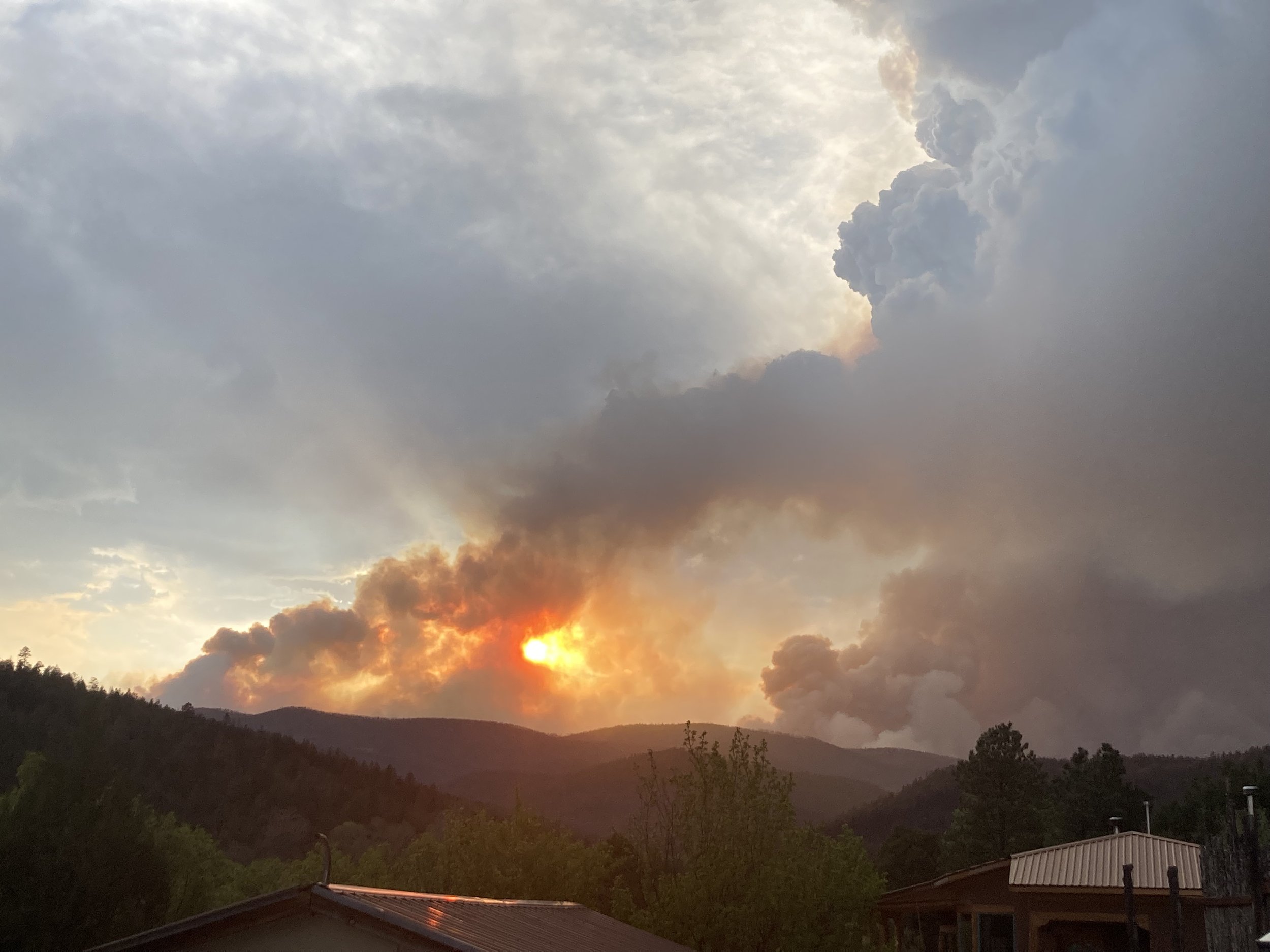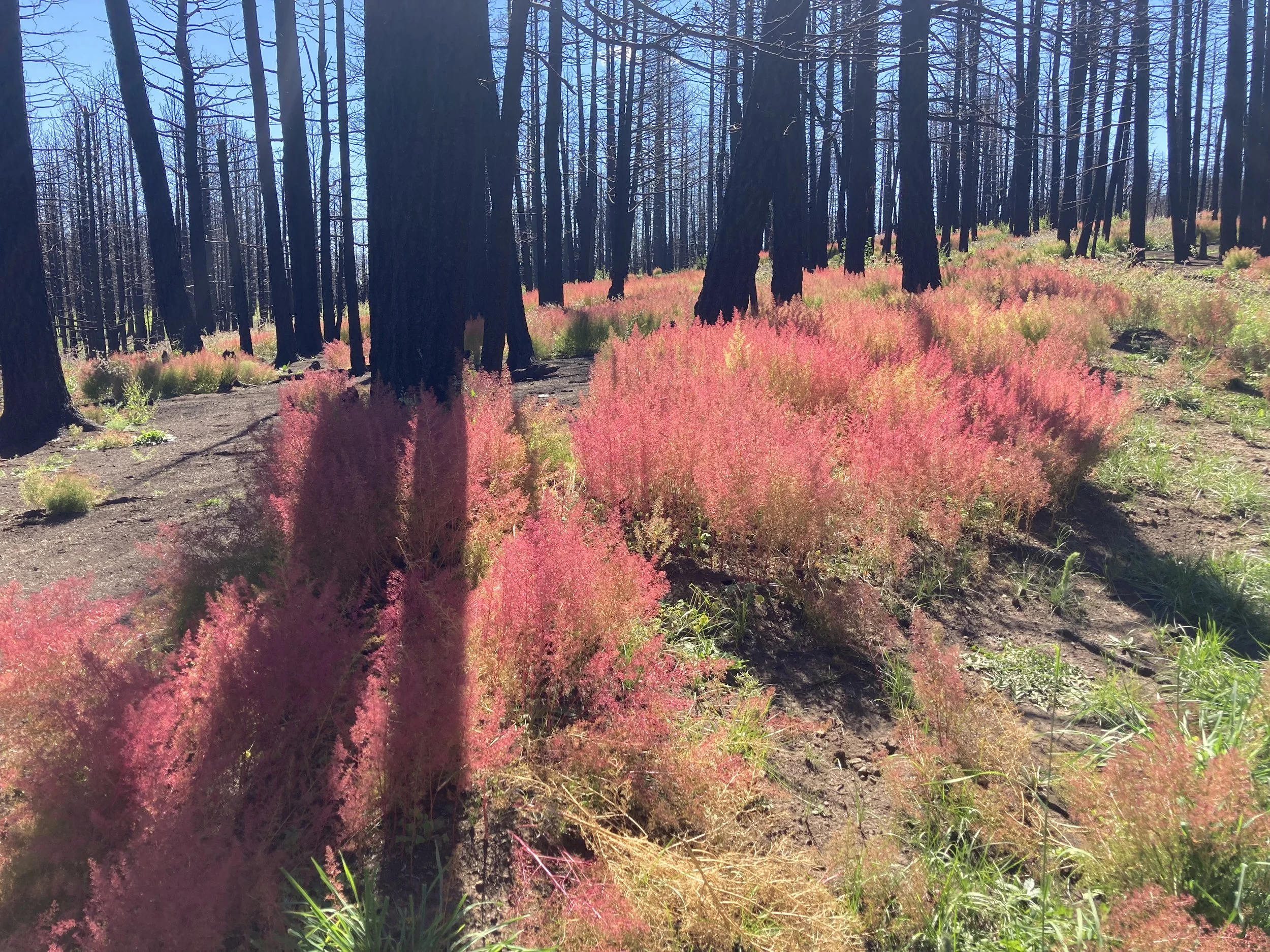
Towards New Paradigms in Community and Ecosystem Empowerment and Renewal
In New Mexico and across the West, we see the consequences of competition, division, fragmentary policies, and short-sighted planning in the too-thick stands of trees choking our forests, the diminished habitat for wildlife, and the robbing of acequias, fertile farms, and ranchlands of the water needed to sustain life and livelihoods. At the same time, a shortage of well-paying jobs, housing and other limiting resource is leading to the growth of the region's most significant export: our children. These collective failures are also evidenced in the fire scars radiating across our landscapes and the floods that roar down our valleys. The decimated water supplies to cities such as Las Vegas, New Mexico, the lost homes and lifeways, staggering firefighting costs, and incalculable human suffering. We need a new approach to address these challenges!
Our Path of Innovation:
We have been exploring different approaches to community and ecological renewal. The synthesis of these perspectives is essential because they are too often considered in isolation - whereas, in reality, they are intimately entwined. This work builds on decades of experience initiating and sustaining some of the highest-profile collaborative conservation projects on the planet. However, the paradigms that grounded this work are increasingly problematic for three reasons.
First, social and ecological systems are transitioning so fast in an increasingly human-dominated world that traditional assumptions about continuity are no longer adequate - for dramatic events ranging from COVID to wildfire are increasingly the norm. So we have to develop durable approaches that harness nature’s dynamics as well as those of markets - rather than fighting them.
Second, conservation and other forms of social action are increasingly a zero-sum game with more organizations chasing fewer dollars - when in reality, the only true organizational sustainability is by creating one’s own income streams that do not rely on donor dollars.
Third, both economic development and ecological conservation represent paradigms that are increasingly problematic because they are based on assumptions of continual growth and endless resilience that no longer hold - if they ever did. Especially in a world of declining resources, new models are needed, and we use our work as a laboratory to develop new approaches that can be exported across the continent and beyond.
The most important aspect of engineering organizational durability, or what we call prosilience, is through sustaining a principle-based learning organization that is able to evolve and adapt in response to experience - rather than being rigidly hidebound to old paradigms of approaches that do not work or are not viable.
To this end, we began with a focus on renewable energy, using biomass from tree thinning to restore our forests as a means of creating well-paying jobs that would also reduce wildfire risk and improve watershed health. However, following the largest wildfire in New Mexico’s history that burned over much of our region in the spring of 2022, we realized that biomass energy alone could not solve the problem. So we hired Michael Sussman and OnTrackNorthAmerica (https://www.ontracknorthamerica.org), to develop a 9-month intensive effort to better understand forest harvesting logistics. However, after an intensive series of workshops in January 2022 with stakeholders from across the region, it became clear that an enlarged forestry strategy alone was not enough. For even if we succeed in bringing in new mills and other forms of capacity - where would the employees come from, and where would they live? How would culture and other attributes of local livelihoods and well-being be sustained?
This led to the phase we are now undertaking, where we are bringing on a new team with a different set of skills. Enter Mark Lautman and Community Economics Lab and his Economic Engineering project (marklautman.com). Mr. Lautman and his team have realized for decades that current economic development models do not work, and he and his team have been exploring new approaches. The Sangre de Cristo Mountain Initiative, in partnership with Mr. Lautman and his team, represents a dynamic coupling of new paradigms in conservation and economic development. This is occurring at two scales - an overall system focus on San Miguel County, New Mexico, and a general regional approach to forest recovery.
Sangre de Cristo Forest and Watershed Recovery:
Through support from the Las Vegas New Mexico Community Foundation and others, we are working with local and regional economic development organizations, stakeholders, and governments from across the region, coupled with sophisticated ecological analysis, to develop a holistic place-based approach to community and ecological renewal. Beginning with a nested design with partners already active in the process and expanding out across the region, we have significant buy-in from regional, county, and regional leadership in building the process.
Towards a Regional Recovery Strategy:
In addition to an intensive cross-sector approach in San Miguel County - building on over a dozen community meetings supported by the Kalliopeia Foundation in the winter of 2023 we are building a regional economic development strategy focused on forest recovery to create a regenerative circular economy. Through dozens of partners and a database of over 200 people, we have built the trust and social capital to have broad community and ecosystem-level benefits, including:
Fire prevention and reduction (Over $6M in fire mitigation benefits annually)
Help maintain and revive local and Indigenous communities (Without access to healthy forests, people will lose access to their lands and livelihoods – an incalculable loss.)
Gross receipts tax increase to NM (5% of $100M in saw timber revenue will add $5M in new taxes)
Local jobs and income enhancements (Even a single mill and associated jobs in the woods can provide $2M annually in regional benefits)
Increased tax base for counties (e.g., in Mora County, 1.7% of $2,000,000 = $34,000 annually)
Enhanced agricultural, hunting and fishing, and eco-tourism revenues
Watershed protection and enhanced water access for downstream irrigators
The benefits of this integrated approach include:
Additional opportunities for funding from public and private investment through sustainable ecosystem restoration and revitalization
New markets for saw logs and other forest products
Increased harvesting capacity
Intelligent infrastructure and transportation logistics
Value streams for non-merchantable timber and biomass
Investment capital for all stages of the value chain
Blockchain, carbon markets, and other alternative valuation methods
Coordinated ecosystem/watershed, landscape, and community recovery
This Sangre de Cristo Mountain Initiative exemplifies what is possible when diverse individuals and organizations think, plan, and invest together. In addition to an economic and ecological issue, this is a social justice issue, for without forest and watershed health, the whole system collapses. Centuries of culture are on the line. While the income from multiple value streams can pay for the clearing of dead timber and the thinning of green wood, which, in turn, has immense importance to local people who, for centuries, have used our forests for firewood, grazing, hunting, and other traditional purposes. At the same time, forest thinning protects roads, power lines, and watersheds while improving the land’s ecological health. Local communities and state and federal agencies will realize huge returns if we rally around our power as a thoughtful and activated community.
Biomass Energy and Carbon Credits:
With insight from previous partners, such as Mike Berry of High Desert Forestry Solutions, we have been working on developing a biomass energy system in the vicinity of Colfax and Mora Counties, New Mexico. In a pilot project supported by the US Forest Service, we are exploring how to develop biomass energy systems in local schools to reduce their carbon footprint and energy costs. While in partnership with Los Alomas National Labs, and Dr. Chonggang Xu, we are determining the carbon balance benefits of sustainable forestry and how biomass capture can reduce carbon emissions with improving forest and watershed health.
A Principled Project Approach:
In addition to overarching organizational principles outlined elsewhere - we also follow process principles throughout our projects. These include:
We promise to support economically viable forests, watersheds, and community health in alignment with local and Indigenous values and ecological and watershed science.
We will operate with humility and integrity to serve the long-term interests of the land and those who rely on it for their lifeways and traditions.
We will engage with all relevant community members within an open and transparent process that seeks common ground and mutual benefit.
We progress with an understanding that collaboration and coordination to contribute to the common good are more productive than the competition for individual gain
We will recognize and support differing values and viewpoints.
We commit to acting in the near term in a way that serves long-term sustainability.
We work at the most local level possible to empower local and Indigenous peoples, businesses, landowners, agencies, NGOs, and local, state, and national governments to work as a team with the entire system in mind.

